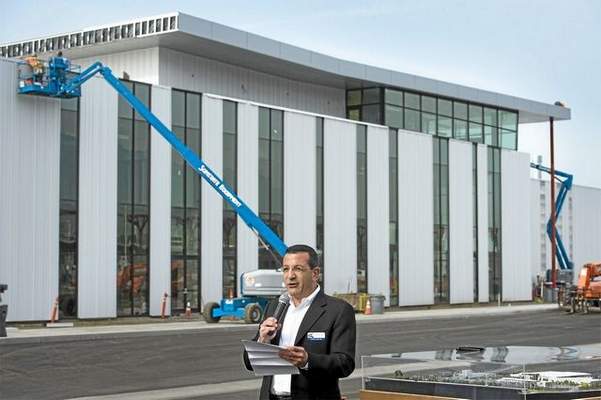The following article appeared in the Pasadena Star-News on April 12, 2015.
New $265-million Gold Line maintenance yard will open in June, ahead of schedule – Pasadena Star-News

Foothill Goldline CEO Habib Balian shows off the new Gold Line Operations Campus complete with solar panels and underground storm water capture in Monrovia, April 10, 2015 . The maintenance yard for all Metro light-rail trains has six miles of track to handle up to 20 trains. Leo Jarzomb — Pasadena Star-News
By Steve Scauzillo
April 12, 2015
MONROVIA >> A sprawling, $265-million Gold Line train operations and maintenance facility here will be completed in June, three months ahead of schedule, officials announced Friday.
The early turnover of the train yard complex — visible from the 210 Freeway — will give the Los Angeles County Metropolitan Transportation Authority (Metro) a head start training mechanics and drivers, which could lead to an earlier than anticipated opening of the 11.5-mile extension from Pasadena to Azusa/Glendora.
“If things go well, it (opening) could be as early as January,” said Habib Balian, CEO of the Foothill Gold Line Construction Authority during an unveiling of the 24-acre facility on Friday. Balian said Metro had recently pinned the opening of the extension to March.
However, as Metro becomes familiar with the maintenance yard, and as soon as the Construction Authority finishes work on the foothill extension in late September, Metro will have more time to install ticket machines and sync the latest Metro rail line with its operations center in downtown Los Angeles.
With a 132,000 square-foot shop building and six miles of storage track, the maintenance yard can accommodate 84 light-rail cars at one time and about 200 employees. Work on trains would include routine and heavy repairs, wheel truing, body repairs, painting, storage, cleaning and washing.
Trains enter the shop building on tracks from the east and are elevated, so that mechanics can have access to the undercarriage. Another hoist positions trains higher, so workers can access the cantilever rods that connect to overhead power lines, Balian said during a tour.
Also on site is a train car wash that recycles the used water.
The Monrovia train yard, on Evergreen Avenue on the north, California Avenue on the west, Shamrock Avenue on the east and Duarte Road on the south, is the largest such facility of its kind, Balian said.
When the $1.5-billion Regional Connector project is complete in 2020, allowing passengers to ride from Azusa to Long Beach without getting off the train, workers will repair trains sent from all lines throughout Metro’s 72-mile rail system.
Metro made an expanded train yard a condition of agreeing to fund and operate the foothill extension, he said. The Construction Authority spent $60 million acquiring the land from five different owners, including winning a contested land sale, he said. What started as a facility to repair 14 train cars for the Gold Line extension turned into a three-story, 84-car facility with a painting room, a parts room with automated storage cabinets and a mini power station.
“Their (Metro’s) facilities are overtaxed. So they expanded it to 24 acres and 84 vehicles,” he said. Currently, Metro moves some trains after being repaired at a downtown L.A. facility on tow trucks during the middle of the night at a cost of $5,000 per ride, Balian said.
In additional to size, the Gold Line operations and maintenance campus contains numerous environmental amenities, making it a LEED (Leadership in Energy and Environmental Design) Gold standard building.
Storm water is captured underground and spun in a vortex to separate out debris. The filtered water is held in below-ground tanks and trickles into the underground aquifer, explained Maryjane MacLeod, storm water consultant for Contech Engineered Solutions. The Huber Heights, Ohio company built water-capture devices at Machado Lake in Harbor City and the South Los Angeles Wetlands Park.
Hot Purple Energy, a Palm Springs-based company, installed a 714-panel, 178.5-kilowatt solar array on the roof of the maintenance canopy. Electricity from the sun will supply one-third of the maintenance facility’s power, said David Herrlinger, vice president.
In addition to drought-resistant landscaping, the Construction Authority installed smart sprinklers that test the soil for moisture content before turning on, Balian said.
Balian said the Authority pushed for a sustainable design that was not in the Metro blueprint. “We challenged designers and engineers to find ways to make the operational campus more sustainable. We now have a Gold standard facility, which has never been done with a facility of this kind.”
